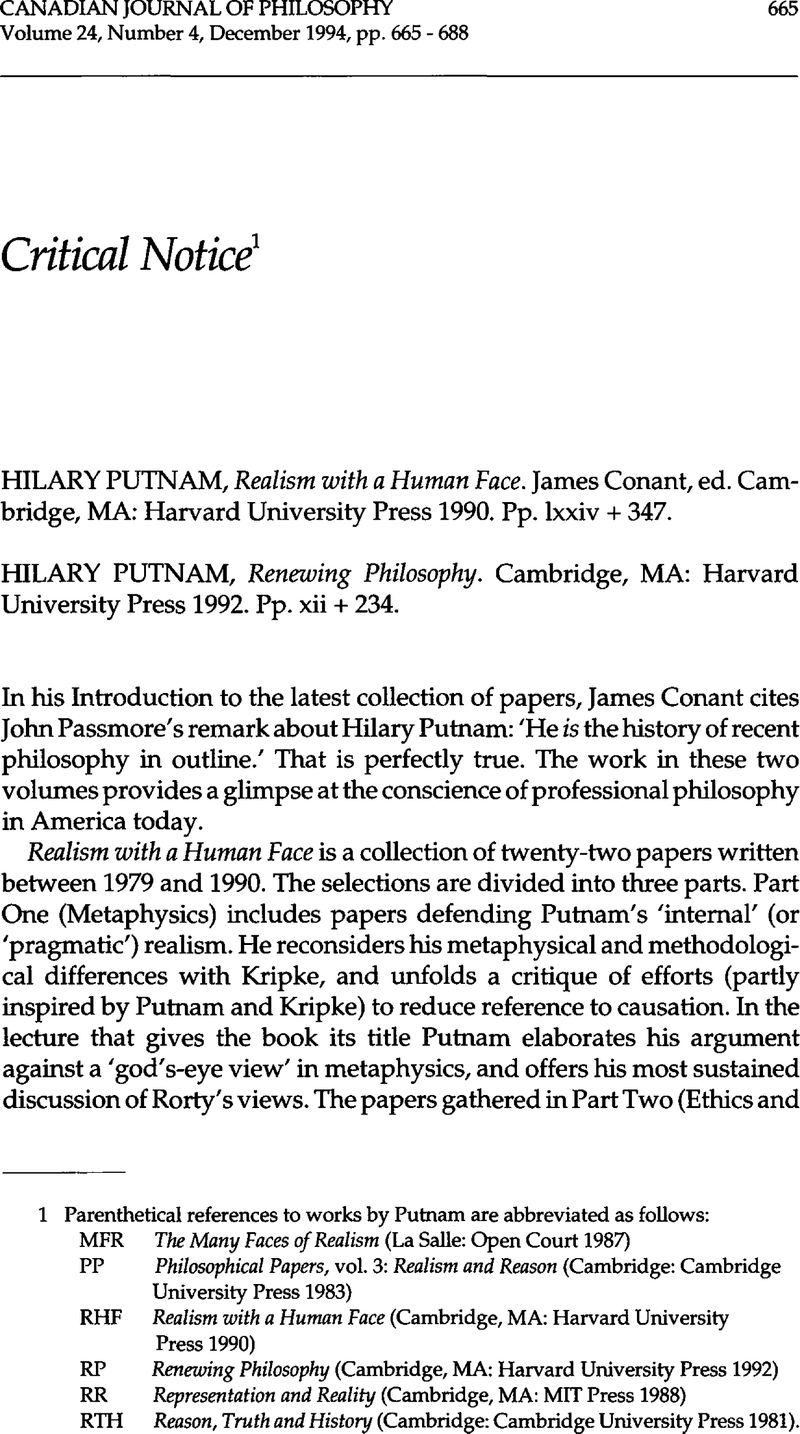No CrossRef data available.
Published online by Cambridge University Press: 01 January 2020

1 Parenthetical references to works by Putnam are abbreviated as follows:
MFR The Many Faces of Realism (La Salle: Open Court 1987)
PP Philosophical Papers, vol. 3: Realism and Reason (Cambridge: Cambridge University Press 1983)
RHF Realism with a Human Face (Cambridge, MA: Harvard University Press 1990)
RP Renewing Philosophy (Cambridge, MA: Harvard University Press 1992)
RR Representation and Reality (Cambridge, MA: MIT Press 1988)
RTH Reason, Truth and History (Cambridge: Cambridge University Press 1981).
2 Hacking, Ian Representing and Intervening (Cambridge: Cambridge University Press 1983), 94CrossRefGoogle Scholar
3 Despite the allusion to Thomas Nagel’s The View from Nowhere (Oxford: Oxford University Press 1986), Nagel does not believe that a fully objective view from absolutely no perspective is humanly attainable. He only wishes it were.
4 Putnam first advanced this argument in ‘Models and Reality’ (1977), where he says: ‘one can “Skolemize” absolutely everything. It seems to be absolutely impossible to fix a determinate reference (without appeal to nonnatural mental powers) for any term at all’ (PP.16). Hacking has wise words of caution about the limitations of Putnam’s argument; see Representing and Intervening, 105-8.
5 Dennett, D.C. The Intentional Stance (Cambridge, MA: MIT Press 1987), 71-3Google Scholar
6 Wittgenstein, Ludwig Philosophical Investigations, 3rd ed. Trans. Anscombe, G.E.M. (Oxford: Blackwell 1967), §118Google Scholar
7 Putnam observes that ‘the “motor” of analytic philosophy was logical positivism … not because all analytic philosophers were positivists, but because the arguments pro-and-con positivism were what kept analytic philosophy in motion. Analytic philosophy has already begun to lose shape as a tendency with the disappearance of a strong ideological current at its center’ (PP.303). Consider in this light Steven Schiffer’s recent frankness: ‘I do not know how to give an interesting answer to the challenge to say what I do for a living. I do not know how to define myself professionally … Maybe the answer lies in some alliance with cognitive science’ (Remnants of Meaning [Cambridge, MA: MIT Press 1987], 271).
8 ‘[As] in the most contemporary idiom so in Homer and Sophocles: The man who speaks the truth “tells it like it is,” and the liar tells it otherwise … truth depends on some point of similarity or agreement between … what is said or thought … [and] what is or what is actually the case … [T]his is the ordinary Greek notion of telling or knowing the truth, from Homer to Aristotle’ (Kahn, C.H. The Verb ‘Be’ in Ancient Greek [Dordrecht: Reidel 1973], 363)Google Scholar.
9 ‘How then does it come about that we posit an object for these representations, and so, in addition to their subjective reality as modifications, ascribe to them some mysterious kind of objective reality?’ (Critique of Pure Reason, trans. N. Kemp Smith [London: Macmillan 1933], A197 /B242)
10 This may be the answer to Putnam’s question why ‘philosophers, of all people, should be the ones to think that the fact that certain ideas are intrinsically controversial indicates that there is no being objectively right or wrong about those ideas’ (RHF.35). Interpret ‘objectively right or wrong’ as ‘empirically (or scientifically) right or wrong’ and one has Kant’s own position.
11 Parmenides, fragment 1; and Collingwood, R. G. The Idea of Nature (Oxford: Oxford University Press 1945), 69Google Scholar
12 Eck, Marcel Lies and Truth, trans. Marchland, B. (London: Macmillan 1970), 103Google Scholar
13 lhis is a point I argue in Truth in Philosophy (Cambridge, MA: Harvard University Press 1993).
14 Goodman, Nelson Of Mind and Other Matters (Cambridge, MA: Harvard University Press 1984), 39Google Scholar
15 Goodman, Mind and Other Matters, 38
16 ‘Any treatment of rightness may, of course, give rise to speculation concerning an application to moral rightness; but I willingly leave that to others. One point might be pondered though: in the present context at least, relativity of rightness and the admissability of conflicting right renderings in no way precludes rigorous standards for distinguishing right from wrong’ (Goodman, Nelson Ways of Worldmaking [Indianapolis: Hackett 1978], 109-10nGoogle Scholar.). Putnam’s interpretation of objective judgment seems to be a development of this point.
17 Goodman, Mind and Other Matters, 38. Neither Williams nor Nagel discuss Goodman’s ‘new riddle of induction’ when they explain their ideas on the absolute conception or the view from nowhere. It is difficult to see how they could allow Goodman’s argument to stand without forsaking the absoluteness of future science. It is even more difficult to see how they could answer it.
18 Rorty, Richard Consequences of Pragmatism (Minneapolis: University of Minnesota Press 1982), 165Google Scholar. As he is the ancestor of all metaphysical absolutism it is worth recalling that for Parmenides the capacity to withstand refutation is the criterion of truth. See David Furley, ‘Truth as What Survives the Elenchus: An Idea in Parmenides,’ in Huby, P. and Neal, G. eds., The Criterion of Truth (Liverpool: Liverpool University Press 1989)Google Scholar.
19 See Rorty, Richard ‘Pragmatism, Davidson, and Truth,’ Objectivity, Relativism, and Truth, Philosophical Papers, vol. 1 (Cambridge: Cambridge University Press 1991)Google Scholar.
20 Rorty, Objectivity, Relativism, and Truth, 128, 132
21 Rorty, Richard Philosophy and the Mirror of Nature (Princeton: Princeton University Press 1979), 320,316Google Scholar. It is even harder to find traces of computationism in Contingency, Irony, and Solidarity (Cambridge: Cambridge University Press 1989). I cannot find a passage in either book that actually says there is an algorithm for truth or justification.
22 Rorty, Objectivity, Relativism, and Truth, 25-6, 217
23 Rorty, Richard ‘Putnam and the Relativist Menace,’ Journal of Philosophy 90 (1993) 451-2CrossRefGoogle Scholar
24 Rorty, Objectivity, Relativism, and Truth, 207-8
25 Rorty, ‘Putnam and the Relativist Menace,’ 459-60; citing Putnam, PP.246
26 Rorty, ‘Putnam and the Relativist Menace,’ 446-7
27 Rorty, Objectivity, Relativism, and Truth, 13
28 Rorty, Consequences of Pragmatism, xv